FORD F750 2002 10.G Owners Manual
Manufacturer: FORD, Model Year: 2002, Model line: F750, Model: FORD F750 2002 10.GPages: 256, PDF Size: 1.75 MB
Page 231 of 256
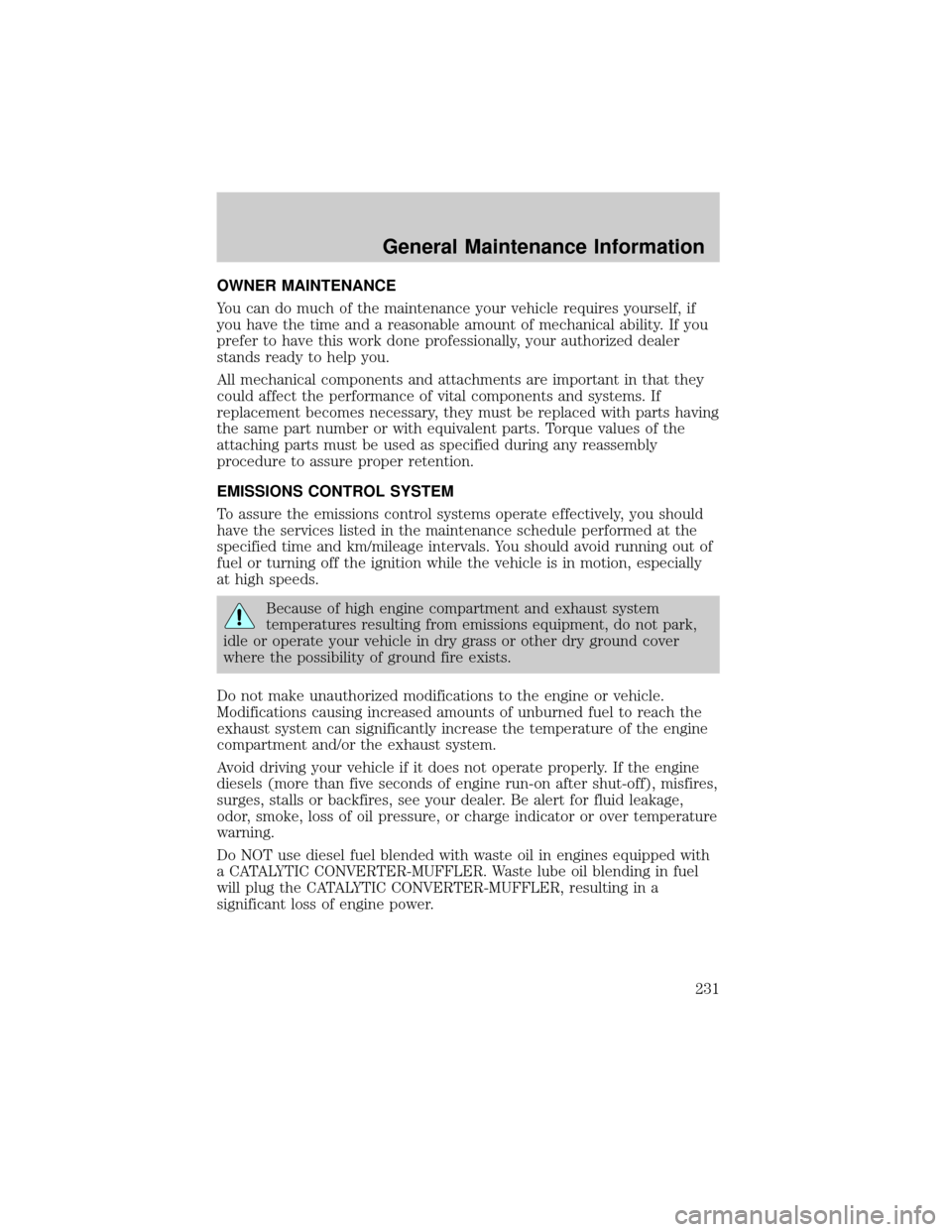
OWNER MAINTENANCE
You can do much of the maintenance your vehicle requires yourself, if
you have the time and a reasonable amount of mechanical ability. If you
prefer to have this work done professionally, your authorized dealer
stands ready to help you.
All mechanical components and attachments are important in that they
could affect the performance of vital components and systems. If
replacement becomes necessary, they must be replaced with parts having
the same part number or with equivalent parts. Torque values of the
attaching parts must be used as specified during any reassembly
procedure to assure proper retention.
EMISSIONS CONTROL SYSTEM
To assure the emissions control systems operate effectively, you should
have the services listed in the maintenance schedule performed at the
specified time and km/mileage intervals. You should avoid running out of
fuel or turning off the ignition while the vehicle is in motion, especially
at high speeds.
Because of high engine compartment and exhaust system
temperatures resulting from emissions equipment, do not park,
idle or operate your vehicle in dry grass or other dry ground cover
where the possibility of ground fire exists.
Do not make unauthorized modifications to the engine or vehicle.
Modifications causing increased amounts of unburned fuel to reach the
exhaust system can significantly increase the temperature of the engine
compartment and/or the exhaust system.
Avoid driving your vehicle if it does not operate properly. If the engine
diesels (more than five seconds of engine run-on after shut-off), misfires,
surges, stalls or backfires, see your dealer. Be alert for fluid leakage,
odor, smoke, loss of oil pressure, or charge indicator or over temperature
warning.
Do NOT use diesel fuel blended with waste oil in engines equipped with
a CATALYTIC CONVERTER-MUFFLER. Waste lube oil blending in fuel
will plug the CATALYTIC CONVERTER-MUFFLER, resulting in a
significant loss of engine power.
General Maintenance Information
231
Page 232 of 256
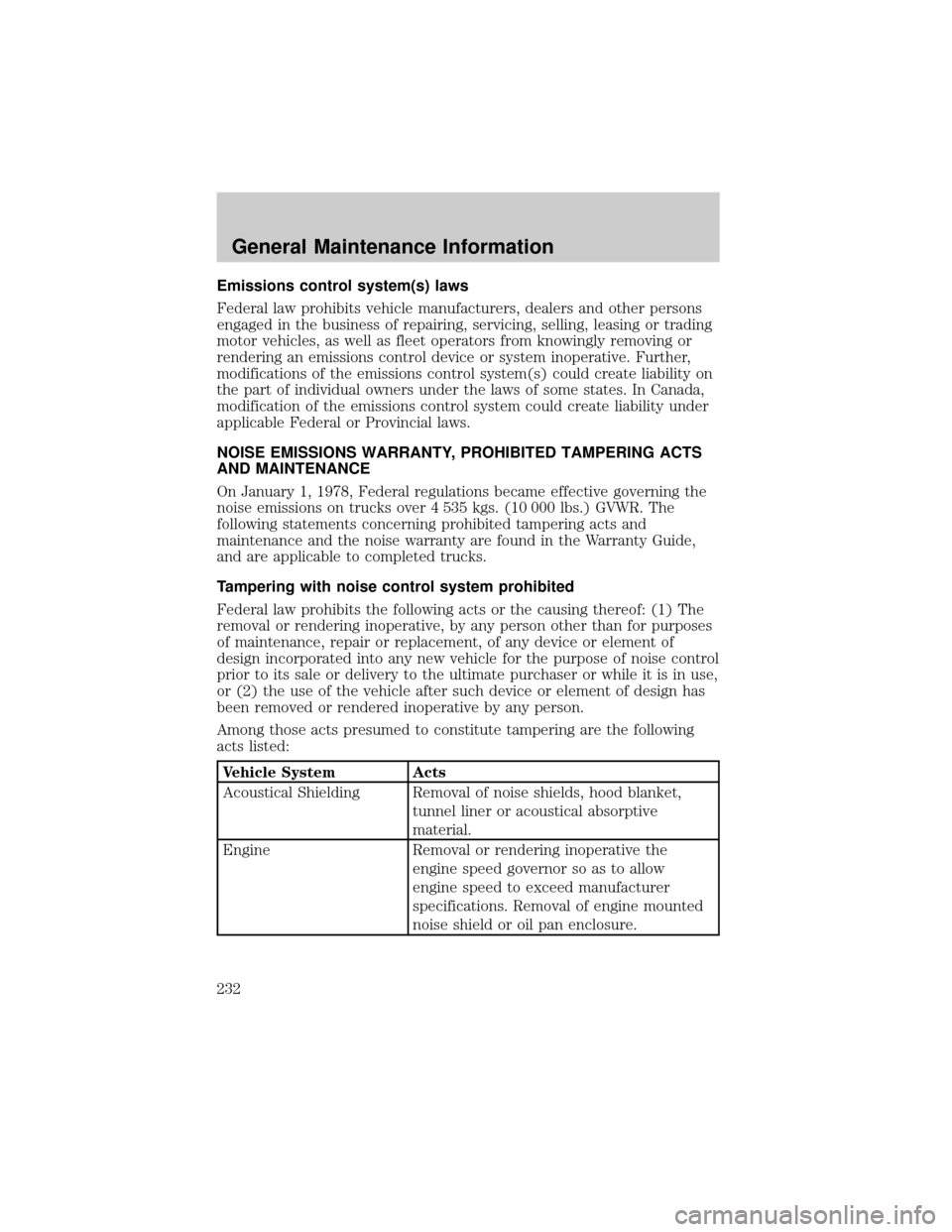
Emissions control system(s) laws
Federal law prohibits vehicle manufacturers, dealers and other persons
engaged in the business of repairing, servicing, selling, leasing or trading
motor vehicles, as well as fleet operators from knowingly removing or
rendering an emissions control device or system inoperative. Further,
modifications of the emissions control system(s) could create liability on
the part of individual owners under the laws of some states. In Canada,
modification of the emissions control system could create liability under
applicable Federal or Provincial laws.
NOISE EMISSIONS WARRANTY, PROHIBITED TAMPERING ACTS
AND MAINTENANCE
On January 1, 1978, Federal regulations became effective governing the
noise emissions on trucks over 4 535 kgs. (10 000 lbs.) GVWR. The
following statements concerning prohibited tampering acts and
maintenance and the noise warranty are found in the Warranty Guide,
and are applicable to completed trucks.
Tampering with noise control system prohibited
Federal law prohibits the following acts or the causing thereof: (1) The
removal or rendering inoperative, by any person other than for purposes
of maintenance, repair or replacement, of any device or element of
design incorporated into any new vehicle for the purpose of noise control
prior to its sale or delivery to the ultimate purchaser or while it is in use,
or (2) the use of the vehicle after such device or element of design has
been removed or rendered inoperative by any person.
Among those acts presumed to constitute tampering are the following
acts listed:
Vehicle System Acts
Acoustical Shielding Removal of noise shields, hood blanket,
tunnel liner or acoustical absorptive
material.
Engine Removal or rendering inoperative the
engine speed governor so as to allow
engine speed to exceed manufacturer
specifications. Removal of engine mounted
noise shield or oil pan enclosure.
General Maintenance Information
232
Page 233 of 256
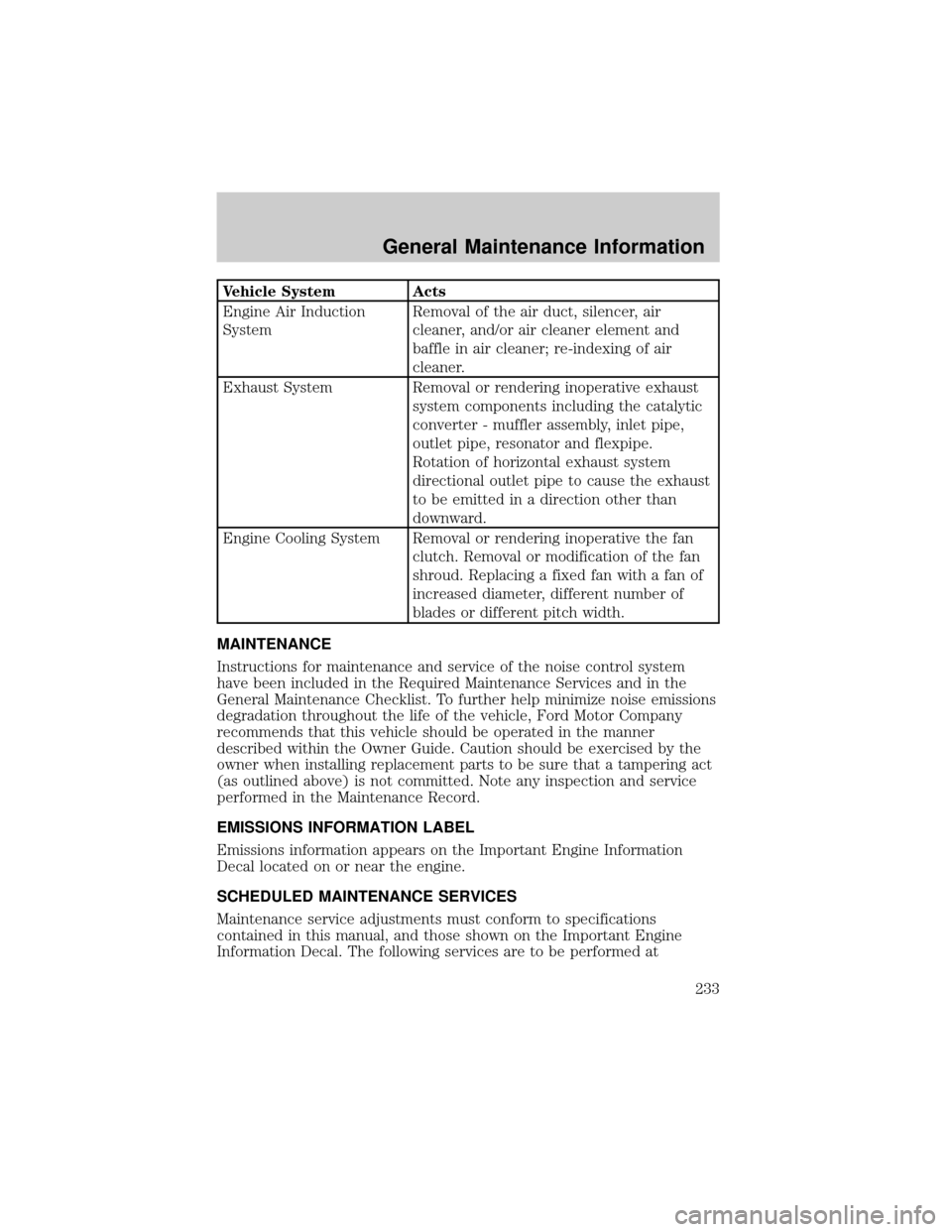
Vehicle System Acts
Engine Air Induction
SystemRemoval of the air duct, silencer, air
cleaner, and/or air cleaner element and
baffle in air cleaner; re-indexing of air
cleaner.
Exhaust System Removal or rendering inoperative exhaust
system components including the catalytic
converter - muffler assembly, inlet pipe,
outlet pipe, resonator and flexpipe.
Rotation of horizontal exhaust system
directional outlet pipe to cause the exhaust
to be emitted in a direction other than
downward.
Engine Cooling System Removal or rendering inoperative the fan
clutch. Removal or modification of the fan
shroud. Replacing a fixed fan with a fan of
increased diameter, different number of
blades or different pitch width.
MAINTENANCE
Instructions for maintenance and service of the noise control system
have been included in the Required Maintenance Services and in the
General Maintenance Checklist. To further help minimize noise emissions
degradation throughout the life of the vehicle, Ford Motor Company
recommends that this vehicle should be operated in the manner
described within the Owner Guide. Caution should be exercised by the
owner when installing replacement parts to be sure that a tampering act
(as outlined above) is not committed. Note any inspection and service
performed in the Maintenance Record.
EMISSIONS INFORMATION LABEL
Emissions information appears on the Important Engine Information
Decal located on or near the engine.
SCHEDULED MAINTENANCE SERVICES
Maintenance service adjustments must conform to specifications
contained in this manual, and those shown on the Important Engine
Information Decal. The following services are to be performed at
General Maintenance Information
233
Page 234 of 256
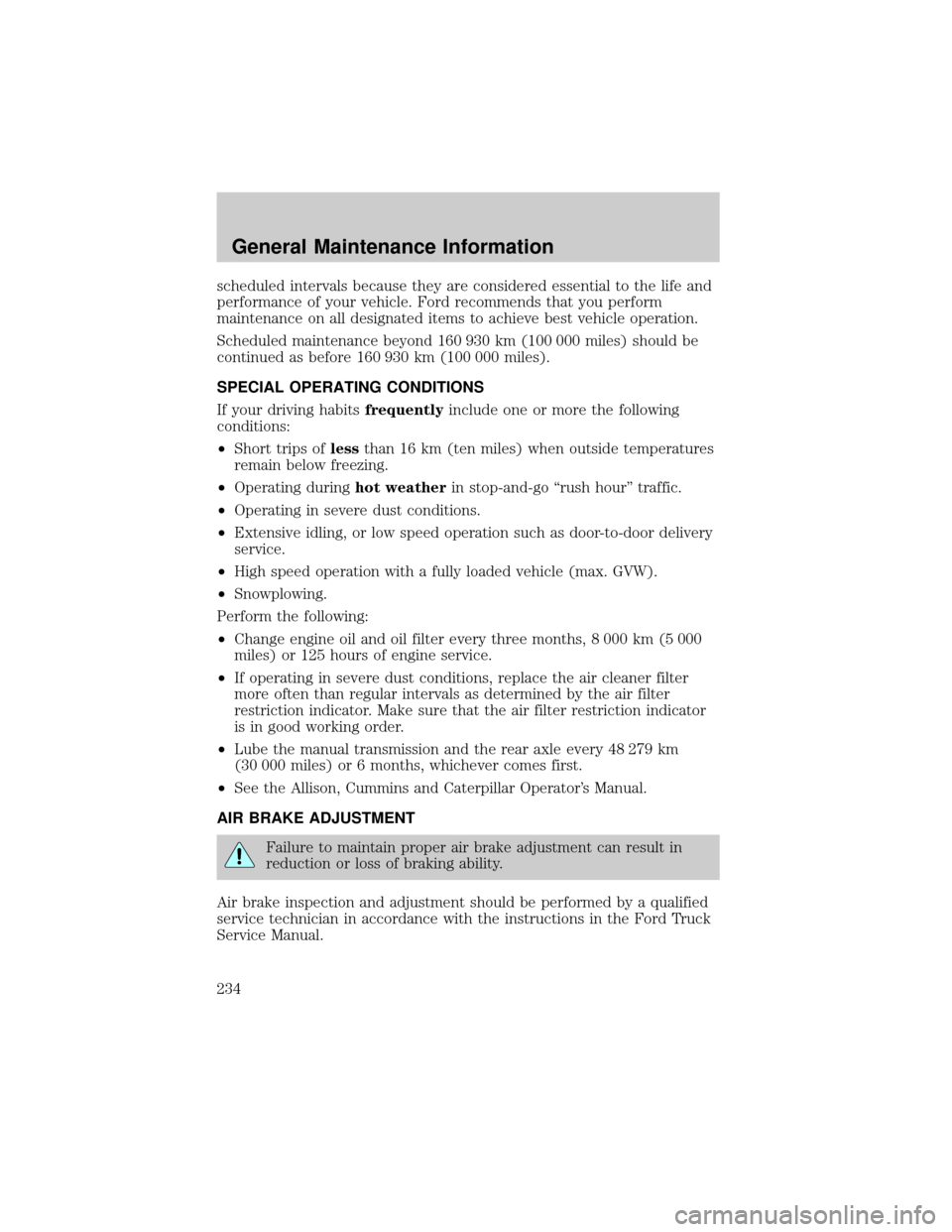
scheduled intervals because they are considered essential to the life and
performance of your vehicle. Ford recommends that you perform
maintenance on all designated items to achieve best vehicle operation.
Scheduled maintenance beyond 160 930 km (100 000 miles) should be
continued as before 160 930 km (100 000 miles).
SPECIAL OPERATING CONDITIONS
If your driving habitsfrequentlyinclude one or more the following
conditions:
²Short trips oflessthan 16 km (ten miles) when outside temperatures
remain below freezing.
²Operating duringhot weatherin stop-and-go ªrush hourº traffic.
²Operating in severe dust conditions.
²Extensive idling, or low speed operation such as door-to-door delivery
service.
²High speed operation with a fully loaded vehicle (max. GVW).
²Snowplowing.
Perform the following:
²Change engine oil and oil filter every three months, 8 000 km (5 000
miles) or 125 hours of engine service.
²If operating in severe dust conditions, replace the air cleaner filter
more often than regular intervals as determined by the air filter
restriction indicator. Make sure that the air filter restriction indicator
is in good working order.
²Lube the manual transmission and the rear axle every 48 279 km
(30 000 miles) or 6 months, whichever comes first.
²See the Allison, Cummins and Caterpillar Operator's Manual.
AIR BRAKE ADJUSTMENT
Failure to maintain proper air brake adjustment can result in
reduction or loss of braking ability.
Air brake inspection and adjustment should be performed by a qualified
service technician in accordance with the instructions in the Ford Truck
Service Manual.
General Maintenance Information
234
Page 235 of 256
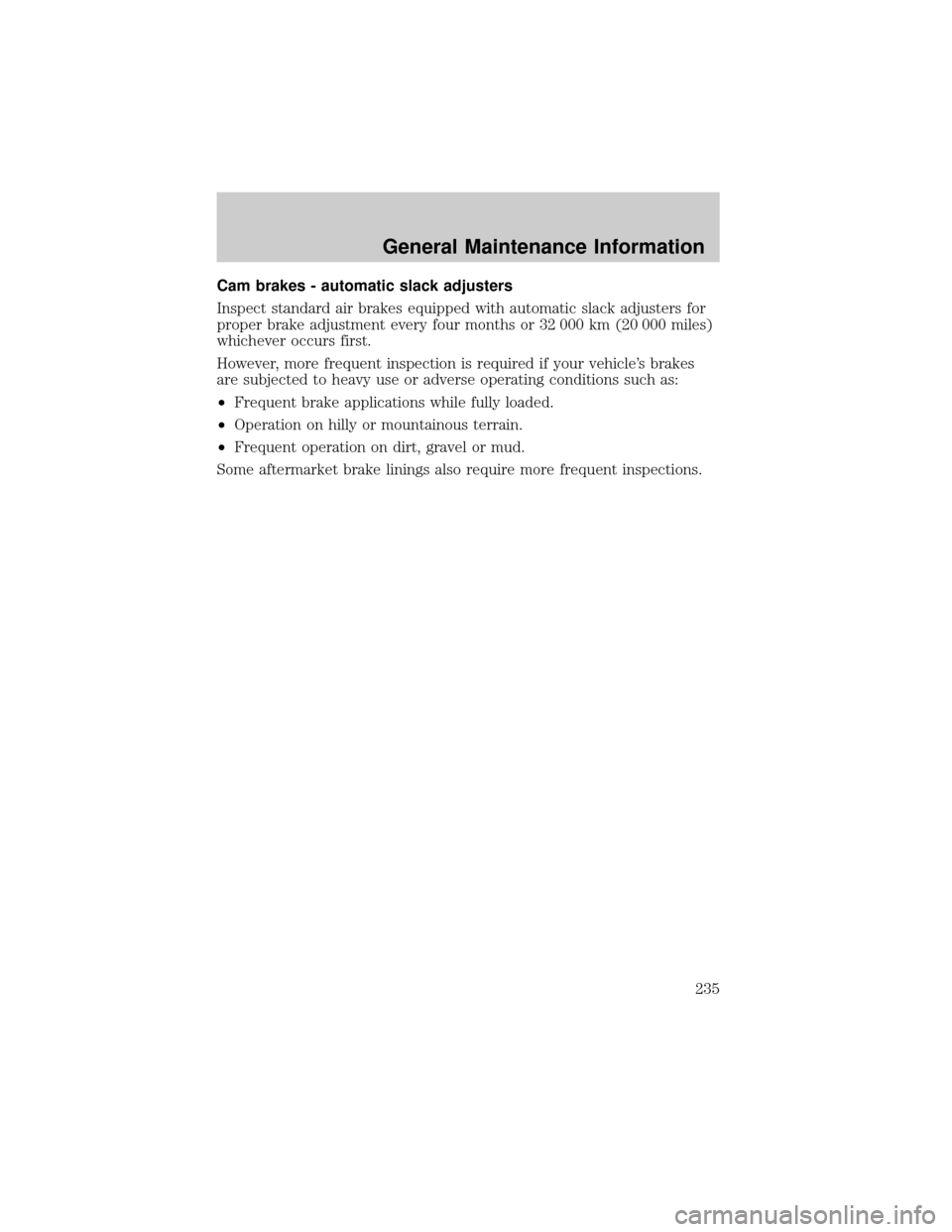
Cam brakes - automatic slack adjusters
Inspect standard air brakes equipped with automatic slack adjusters for
proper brake adjustment every four months or 32 000 km (20 000 miles)
whichever occurs first.
However, more frequent inspection is required if your vehicle's brakes
are subjected to heavy use or adverse operating conditions such as:
²Frequent brake applications while fully loaded.
²Operation on hilly or mountainous terrain.
²Frequent operation on dirt, gravel or mud.
Some aftermarket brake linings also require more frequent inspections.
General Maintenance Information
235
Page 236 of 256

SCHEDULED MAINTENANCE GUIDE
MAINTENANCE SERVICES AND RECORD RETENTION
The maintenance record form which follows is for your convenience. In addition to recording the services performed, you should
retain copies of your receipts for the services. You also should keep records of any emission control systems maintenance
services performed on your vehicle.
Maintenance Record
Warranty
Start Date ______________________________________ Engine Displacement ______________________________________
Vehicle
Identification
Number _________________________________________ Owner Name ___________________________________________
IMPORTANT — This document should remain with the vehicle at all times.
General Maintenance Information
236
Page 237 of 256
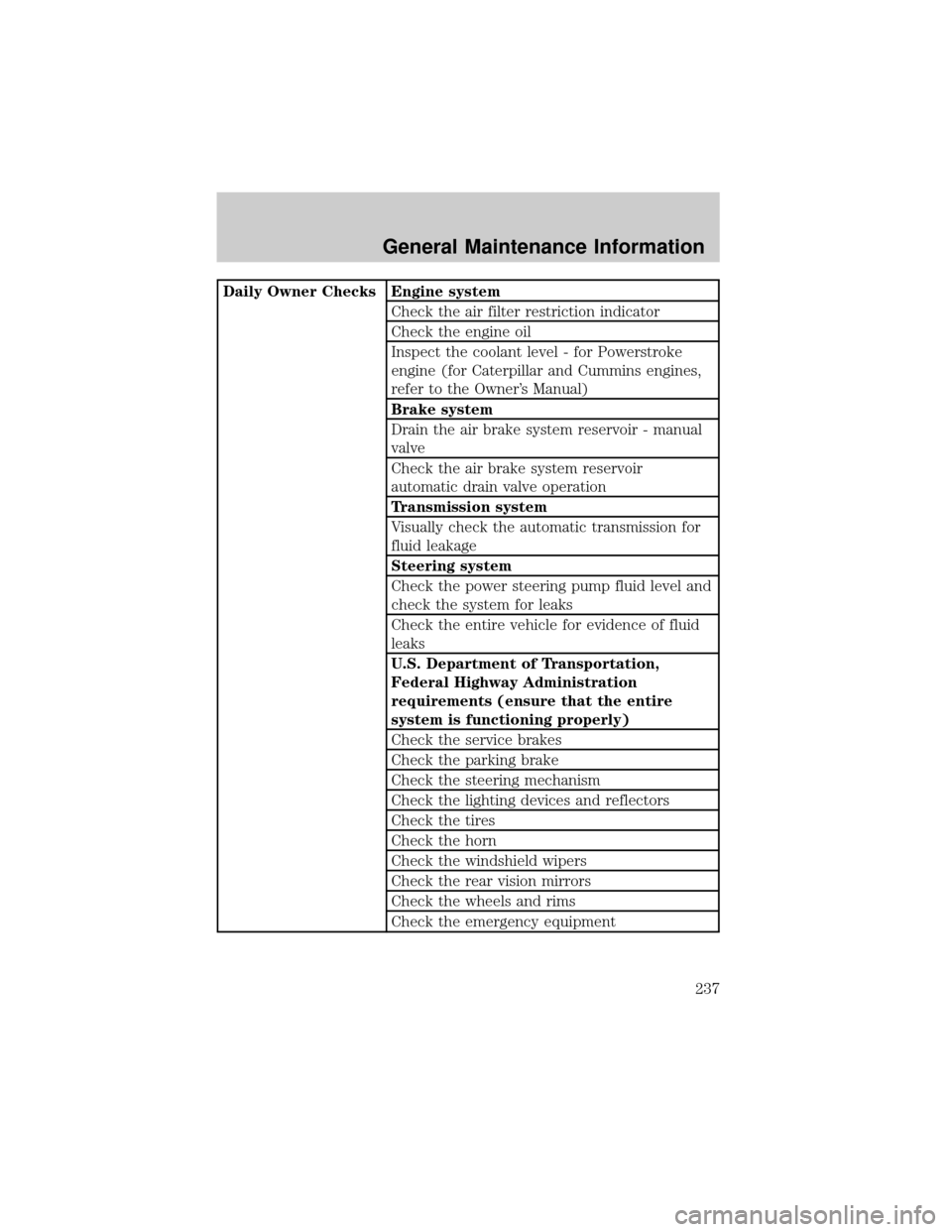
Daily Owner Checks Engine system
Check the air filter restriction indicator
Check the engine oil
Inspect the coolant level - for Powerstroke
engine (for Caterpillar and Cummins engines,
refer to the Owner's Manual)
Brake system
Drain the air brake system reservoir - manual
valve
Check the air brake system reservoir
automatic drain valve operation
Transmission system
Visually check the automatic transmission for
fluid leakage
Steering system
Check the power steering pump fluid level and
check the system for leaks
Check the entire vehicle for evidence of fluid
leaks
U.S. Department of Transportation,
Federal Highway Administration
requirements (ensure that the entire
system is functioning properly)
Check the service brakes
Check the parking brake
Check the steering mechanism
Check the lighting devices and reflectors
Check the tires
Check the horn
Check the windshield wipers
Check the rear vision mirrors
Check the wheels and rims
Check the emergency equipment
General Maintenance Information
237
Page 238 of 256
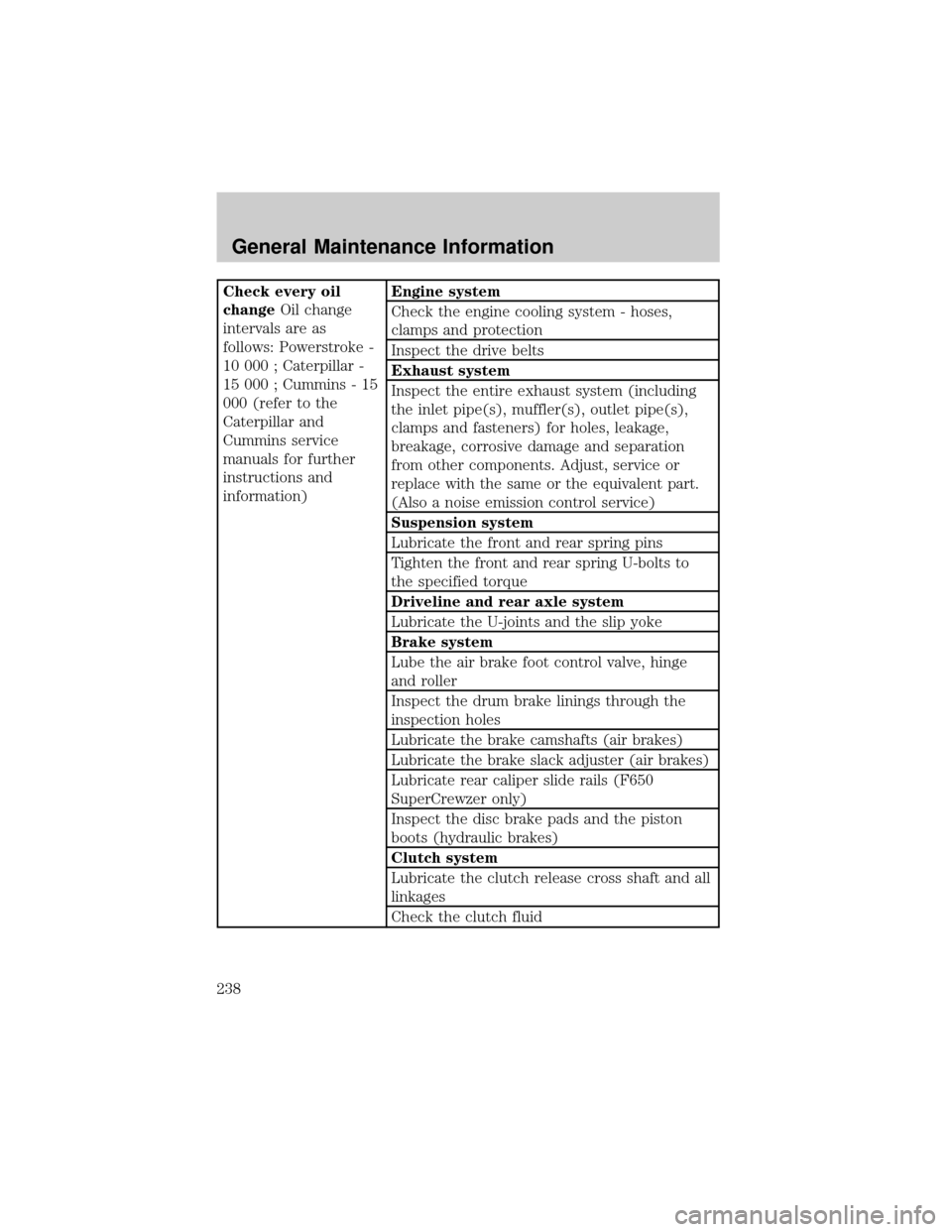
Check every oil
changeOil change
intervals are as
follows: Powerstroke -
10 000 ; Caterpillar -
15 000 ; Cummins - 15
000 (refer to the
Caterpillar and
Cummins service
manuals for further
instructions and
information)Engine system
Check the engine cooling system - hoses,
clamps and protection
Inspect the drive belts
Exhaust system
Inspect the entire exhaust system (including
the inlet pipe(s), muffler(s), outlet pipe(s),
clamps and fasteners) for holes, leakage,
breakage, corrosive damage and separation
from other components. Adjust, service or
replace with the same or the equivalent part.
(Also a noise emission control service)
Suspension system
Lubricate the front and rear spring pins
Tighten the front and rear spring U-bolts to
the specified torque
Driveline and rear axle system
Lubricate the U-joints and the slip yoke
Brake system
Lube the air brake foot control valve, hinge
and roller
Inspect the drum brake linings through the
inspection holes
Lubricate the brake camshafts (air brakes)
Lubricate the brake slack adjuster (air brakes)
Lubricate rear caliper slide rails (F650
SuperCrewzer only)
Inspect the disc brake pads and the piston
boots (hydraulic brakes)
Clutch system
Lubricate the clutch release cross shaft and all
linkages
Check the clutch fluid
General Maintenance Information
238
Page 239 of 256
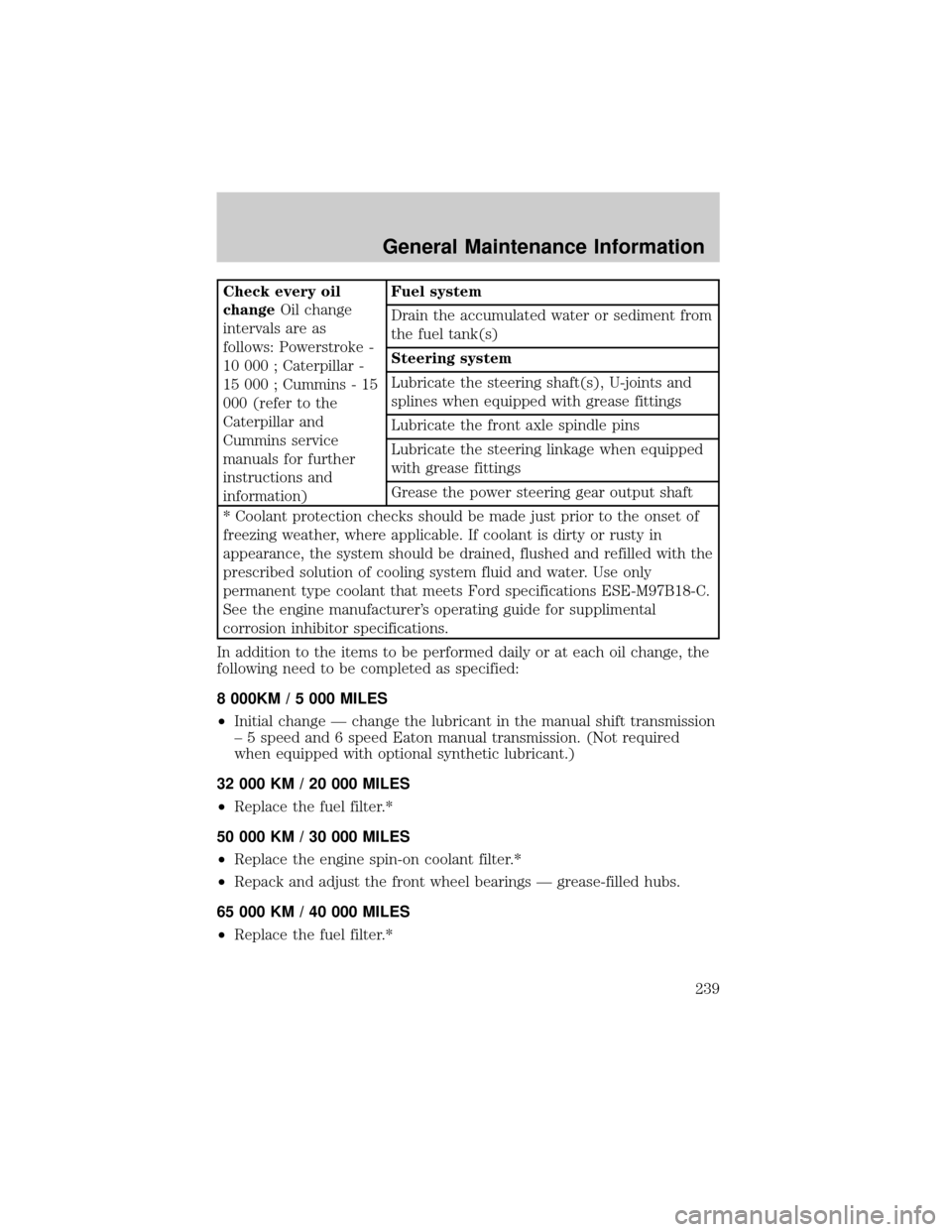
Check every oil
changeOil change
intervals are as
follows: Powerstroke -
10 000 ; Caterpillar -
15 000 ; Cummins - 15
000 (refer to the
Caterpillar and
Cummins service
manuals for further
instructions and
information)Fuel system
Drain the accumulated water or sediment from
the fuel tank(s)
Steering system
Lubricate the steering shaft(s), U-joints and
splines when equipped with grease fittings
Lubricate the front axle spindle pins
Lubricate the steering linkage when equipped
with grease fittings
Grease the power steering gear output shaft
* Coolant protection checks should be made just prior to the onset of
freezing weather, where applicable. If coolant is dirty or rusty in
appearance, the system should be drained, flushed and refilled with the
prescribed solution of cooling system fluid and water. Use only
permanent type coolant that meets Ford specifications ESE-M97B18-C.
See the engine manufacturer's operating guide for supplimental
corrosion inhibitor specifications.
In addition to the items to be performed daily or at each oil change, the
following need to be completed as specified:
8 000KM / 5 000 MILES
²Initial change Ð change the lubricant in the manual shift transmission
± 5 speed and 6 speed Eaton manual transmission. (Not required
when equipped with optional synthetic lubricant.)
32 000 KM / 20 000 MILES
²Replace the fuel filter.*
50 000 KM / 30 000 MILES
²Replace the engine spin-on coolant filter.*
²Repack and adjust the front wheel bearings Ð grease-filled hubs.
65 000 KM / 40 000 MILES
²Replace the fuel filter.*
General Maintenance Information
239
Page 240 of 256

80 000 KM / 50 000 MILES
²Disassemble the single check valve (SC-2) and the automatic drain
valve (DB±2) Ð clean and inspect the valve for wear and
deterioration.
100 000 KM / 60 000 MILES
²Replace the engine spin-on coolant filter.*
²Oil filled front hubsÐ drain oil, adjust bearings and refill the front
hubs with oil. (Not required when equipped with optional synthetic
lubricant.)
²Drain the oil, adjust the bearing and refill with axle lubricant Ð oil
filled hubs.
²Replace the fuel filter.*
²Change the manual transmission oil Ð Eaton 5 and 6 speeds only.
(Not required when equipped with optional synthetic lubricant.)
110 000 KM / 70 000 MILES
²Replace the engine spin-on coolant filter.*
²Replace the engine coolant.* See the engine manufacturer's operating
guide for supplemental corrosion inhibitor specifications.
130 000 KM / 80 000 MILES
²Replace the fuel filter.*
150 000 KM / 90 000 MILES
²Replace the engine spin-on coolant filter*.
²Repack and adjust the front wheel bearings Ð grease-filled hubs.
²Change the lubricant in the manual shift transmission ± 7 speed
Spicer. (Not required when equipped with optional synthetic
lubricant.)
²Change the power steering fluid and filter.
General Maintenance Information
240